
GS Best Trade Ideas Across Assets_watermark
.pdf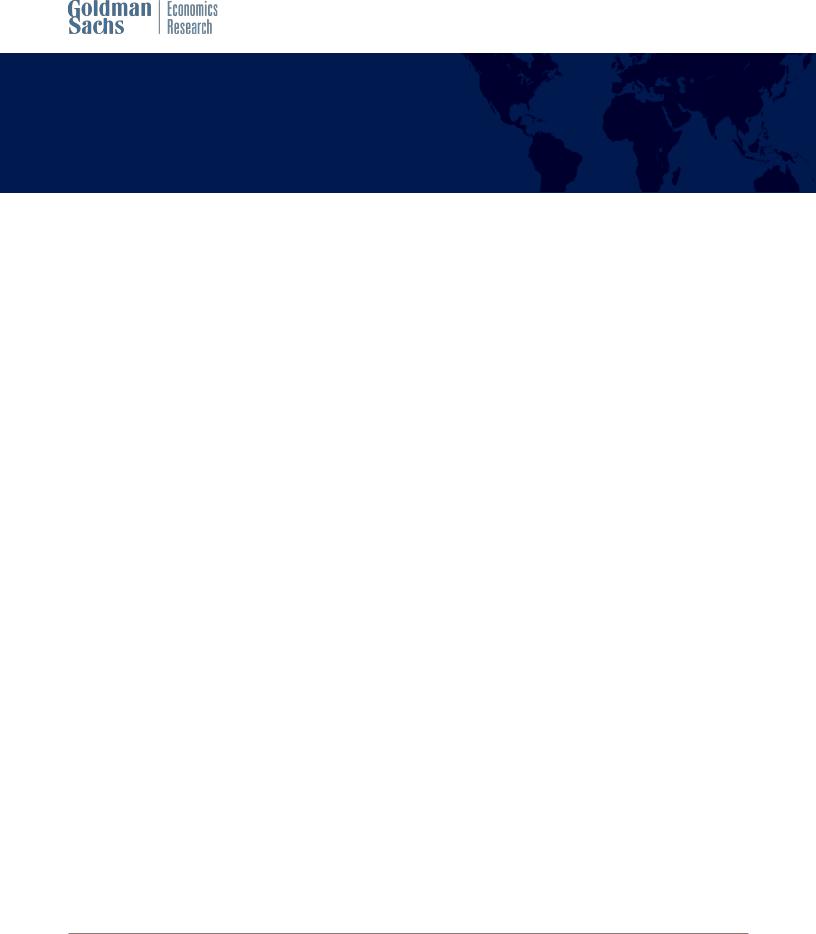
vk.com/id446425943
Global Viewpoint
Best Trade Ideas Across Assets
US: Late-Cycle Dynamics
nLong 5-year US inflation swaps
nEnter 2s30s UST flattener
nLong agency MBS vs. IG credit
nShort IG idiosyncratic risk funded with AAA CMBX
China: Growth Bottoming Out Soon
nLong AUD & NZD vs. EUR
nLong CLP funded out of CNY
nLong S&P GSCI Industrial Metals Index®
EM: Pick Up Excess Risk Premium, Have Hedges
nLong MSCI EM hedged with MSCI EAFE
nReceive a basket of high-yielders 5-year swaps (ZAR, MXN, COP) vs. 10-year swaps in low-yielders (PLN, HUF, THB, KRW)
nLong IDR 10-year bonds
nShort KRW vs top-6 currencies in GS trade-weighted basket
Brexit: Deal Dividend
n Pay 2y1y SONIA versus receive 2y1y EONIA
Central Banks: Data Driving Divergence
nShort EUR/SEK
nShort USD/CAD
nLong PHP vs. top-7 currencies in GS trade-weighted basket
nLong SGD/THB
15 November 2018 | 10:48AM EST
Charles P. Himmelberg
+1(917)343-3218 | charles.himmelberg@gs.com Goldman Sachs & Co. LLC
Lotfi Karoui
+1(917)343-1548 | lotfi.karoui@gs.com Goldman Sachs & Co. LLC
Zach Pandl
+1(212)902-5699 | zach.pandl@gs.com Goldman Sachs & Co. LLC
Kamakshya Trivedi
+44(20)7051-4005 | kamakshya.trivedi@gs.com Goldman Sachs International
Kenneth Ho
+852-2978-7468 | kenneth.ho@gs.com Goldman Sachs (Asia) L.L.C.
Praveen Korapaty
+1(212)357-0413 | praveen.korapaty@gs.com Goldman Sachs & Co. LLC
Caesar Maasry
+1(212)902-8763 | caesar.maasry@gs.com Goldman Sachs & Co. LLC
Marty Young
+1(917)343-3214 | marty.young@gs.com Goldman Sachs & Co. LLC
Danny Suwanapruti
+65-6889-1987 | danny.suwanapruti@gs.com Goldman Sachs (Singapore) Pte
Michael Cahill
+44(20)7552-8314 | michael.e.cahill@gs.com Goldman Sachs International
George Cole
+44(20)7552-1214 | george.cole@gs.com Goldman Sachs International
Ian Tomb
+44(20)7552-2901 | ian.tomb@gs.com Goldman Sachs International
Amanda Lynam, CPA
+1(212)902-9238 | amanda.lynam@gs.com Goldman Sachs & Co. LLC
Investors should consider this report as only a single factor in making their investment decision. For Reg AC certification and other important disclosures, see the Disclosure Appendix, or go to www.gs.com/research/hedge.html.
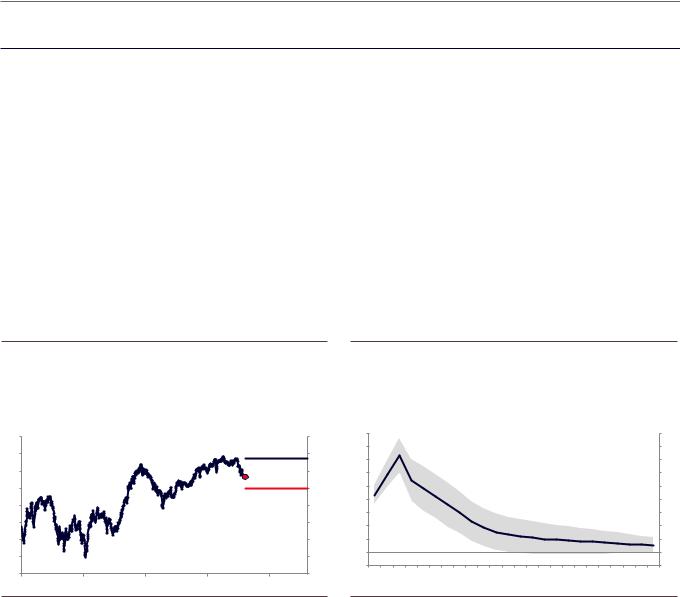
vk.com/id446425943
Goldman Sachs
Global Viewpoint
Best Trade Ideas Across Assets
US: Late-Cycle Dynamics
Long 5-year US inflation swaps; target: 2.35%, stop loss: 2.00%.
We think the US inflation premium is attractive across the curve, particularly given last month’s underperformance (Exhibit 1). In our view, this underperformance reflects concerns over potential overtightening by the Fed (we disagree with this view), weaker and volatile oil prices, and a recent string of misses in core inflation readings. On the last point, our economists have noted cyclical upside risks to these readings, given tight labor markets. Additionally, we think two factors strengthen the case for getting long US inflation: 1) our commodities strategists’ view that crude is oversold, and should rebound by year-end (Exhibit 2), 2) our US economists’ view that the trade war will likely escalate, causing the upcoming rounds of tariffs to find their way into inflation readings faster than prior rounds.
Exhibit 1: Long 5-year US inflation swaps |
Exhibit 2: Upside moves in oil should translate into upward |
|
pressure on inflation swaps |
Response of 5-year US inflation swap rates to 10% positive shock to oil
|
|
|
|
|
|
prices |
|
|
|
|
|
|
|
|
|
|
% |
|
Long 5y US Inflation Swap |
|
% |
bp |
|
|
|
|
|
|
|
|
|
bp |
|
2.6 |
|
|
|
|
2.6 |
18 |
|
|
|
|
|
|
|
|
|
18 |
|
|
|
|
16 |
|
|
|
|
|
|
|
|
|
16 |
||
2.4 |
|
|
|
Target = 2.35% |
2.4 |
|
|
|
|
|
|
|
|
|
||
|
|
|
14 |
|
|
|
|
|
|
|
|
|
14 |
|||
|
|
|
|
|
|
|
|
|
|
|
|
|
|
|
||
2.2 |
|
|
|
Current = 2.13% |
2.2 |
12 |
|
|
|
|
|
|
|
|
|
12 |
2.0 |
|
|
|
Stop: 2.0% |
2.0 |
10 |
|
|
|
|
|
|
|
|
|
10 |
1.8 |
|
|
|
1.8 |
8 |
|
|
|
|
|
|
|
|
|
8 |
|
|
|
|
|
6 |
|
|
|
|
|
|
|
|
|
6 |
||
1.6 |
|
|
|
|
1.6 |
|
|
|
|
|
|
|
|
+2 Std dev. |
||
|
|
|
|
4 |
|
|
|
|
|
|
|
|
4 |
|||
|
|
|
|
|
|
|
|
|
|
|
|
|
||||
|
|
|
|
|
|
|
|
|
|
|
|
|
|
|
||
1.4 |
|
|
|
|
1.4 |
2 |
|
|
|
|
|
|
|
|
|
2 |
1.2 |
|
|
|
|
1.2 |
0 |
|
|
|
|
|
|
|
|
-2 Std dev. |
0 |
|
|
|
|
-2 |
|
|
|
|
|
|
|
|
-2 |
|||
1.0 |
|
|
|
|
1.0 |
|
|
|
|
|
|
|
|
|
||
Feb-16 |
Mar-17 |
Apr-18 |
May-19 |
1 |
2 |
3 |
4 |
5 |
6 |
7 |
8 |
9 |
10 11 12 13 14 15 16 17 18 19 20 21 22 23 24 |
|
||
Jan-15 |
|
|
|
|
|
|
|
|
|
|
Months after shock |
|
||||
Source: Bloomberg, Goldman Sachs Global Investment Research |
Source: Goldman Sachs Global Investment Research |
Enter 2s30s UST flattener; target: 25bp (1Q2019), stop loss: 60bp.
We think the front end of the US Treasury yield curve is currently underpricing future Fed hikes, and expect further flattening of the 2s30s US Treasury yield curve in the next few months (Exhibit 3). In our view, the risk that the Fed gets derailed from its intended path over the next 2-3 hikes is low. The trade carries negatively, but ex-ante carry at this stage of the cycle typically tends to be a contrarian indicator of performance as markets have typically underestimated the extent of a Fed tightening cycle (Exhibit 4). We see two risks to this trade. First, yields may turn much more sensitive to elevated supply levels, keeping the 5s30s portion of the curve steeper than usual. Second, a sizable exogenous shock to US economic momentum in the next few months could cause the front end of the curve to rally.
15 November 2018 |
2 |
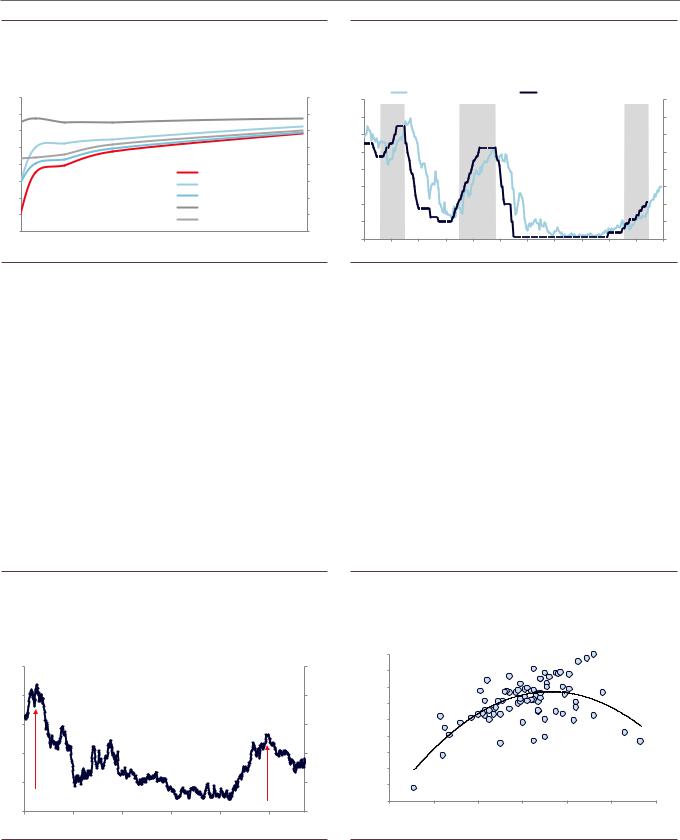
vk.com/id446425943
Goldman Sachs
Global Viewpoint
Exhibit 3: We envision a considerably flatter yield curve than currently priced in forwards
US Treasury yield curves, current, forwards, and GS projections
Exhibit 4: Markets have consistently underestimated the degree of Fed tightening
1y forward instantaneous rate and Fed target rate
% |
|
|
|
|
% |
% |
|
Instanenous 1y forward rate |
|
|
|
|
% |
|||
3.8 |
|
|
|
|
3.8 |
8 |
|
|
Fed Funds Target, 1y ahead |
|||||||
|
|
|
|
|
|
|
|
|
|
|
|
|
8 |
|||
3.6 |
|
|
|
|
3.6 |
7 |
|
|
|
|
|
|
|
|
|
7 |
|
|
|
|
|
|
|
|
|
|
|
|
|
|
|
||
3.4 |
|
|
|
|
3.4 |
6 |
|
|
|
|
|
|
|
|
|
6 |
|
|
|
|
|
|
|
|
|
|
|
|
|
|
|
||
3.2 |
|
|
|
|
3.2 |
5 |
|
|
|
|
|
|
|
|
|
5 |
|
|
|
|
|
|
|
|
|
|
|
|
|
|
|
||
3.0 |
|
|
|
Current |
3.0 |
4 |
|
|
|
|
|
|
|
|
|
4 |
|
|
|
|
|
|
|
|
|
|
|
|
|
|
|||
2.8 |
|
|
|
2.8 |
|
|
|
|
|
|
|
|
|
|
|
|
|
|
|
Q1 2019, GS |
3 |
|
|
|
|
|
|
|
|
|
3 |
||
|
|
|
|
|
|
|
|
|
|
|
|
|
|
|||
|
|
|
|
Q1 2019, Forwards |
|
|
|
|
|
|
|
|
|
|
||
2.6 |
|
|
|
2.6 |
2 |
|
|
|
|
|
|
|
|
|
2 |
|
2.4 |
|
|
|
YE 2019, GS |
2.4 |
|
|
|
|
|
|
|
|
|
||
|
|
|
|
|
|
|
|
|
|
|
|
|
|
|||
|
|
|
YE 2019, Forwards |
1 |
|
|
|
|
|
|
|
|
|
1 |
||
2.2 |
|
|
|
2.2 |
|
|
|
|
|
|
|
|
|
|||
|
|
|
|
0 |
|
|
|
|
|
|
|
|
|
0 |
||
0 |
2 |
5 |
10 |
Tenor |
30 |
1999 |
2001 |
2003 |
2005 |
2007 |
2009 |
2011 |
2013 |
2015 |
||
|
|
|
|
|
1997 |
2017 |
||||||||||
Source: Bloomberg, Goldman Sachs Global Investment Research |
Source: Goldman Sachs Global Investment Research |
Long agency MBS vs. IG credit (rates-hedged); target: 4%, stop loss: -3%.
We recommend getting long 4.5% coupon 30-year conventional pass-throughs hedged with 2-year and 10-year Treasuries (at ratios of 1.0 and 0.25 respectively) vs. the IG corporate bond index (also rates-hedged); at a 2x to 1 notional ratio. The trade is carry positive and reflects two key ingredients. The first is the prospect of slower US growth, which typically allows Agency MBS to outperform IG credit (Exhibit 5). Second is our expectation of a relatively narrow range of outcomes for the Fed, and thus low interest rate volatility; a tailwind for agency MBS excess returns. As shown by Exhibit 6, agency MBS excess returns tend to be positive when interest rates are range-bound, a pattern that reflects the negative convexity of mortgages. We acknowledge that supply/demand technicals will likely remain challenging for the Agency MBS market, as the Federal Reserve’s portfolio holdings continue to run off. But we expect macro fundamentals will likely dominate supply/demand technicals as drivers of relative performance.
Exhibit 5: US agency MBS tend to outperform IG corporate bonds in stressful economic scenarios
Exhibit 6: US agency MBS tend to have positive returns when interest rate moves are small
Cumulative excess returns, long agency MBS FNCL 4.5% vs. short IG |
US agency MBS monthly excess returns vs. monthly change in 10-year |
corporate credit |
|
|
|
|
|
Treasury yield, 1/2012-10/2018 |
|
|
|
|
||||
Index |
|
Agency MBS FNCL 4.5% - IG Corporates |
|
Index |
|
0.6 |
|
|
|
|
|
|
||
124 |
|
|
|
|
|
124 |
|
0.4 |
|
|
|
|
|
|
|
|
|
|
|
|
|
|
|
|
|
|
|
|
|
122 |
|
|
|
|
|
122 |
(%) |
0.2 |
|
|
|
|
|
|
|
|
|
|
|
Return |
0.0 |
|
|
|
|
|
|
||
|
|
|
|
|
|
|
|
|
|
|
|
|
||
|
|
|
|
|
|
|
-0.2 |
|
|
|
|
|
|
|
120 |
|
|
|
|
|
120 |
XS |
|
|
|
|
|
|
|
|
|
|
|
|
|
|
|
|
|
|
|
|||
|
|
|
|
|
|
|
MBS |
-0.4 |
|
|
|
|
|
|
118 |
|
|
|
|
|
118 |
-0.6 |
|
|
|
|
|
|
|
|
|
|
|
|
Agency |
|
|
|
|
|
|
|||
|
|
|
|
|
|
|
-0.8 |
Refi Risk |
|
|
Extension Risk |
|||
116 |
|
|
|
|
|
116 |
|
|
|
|||||
|
|
|
|
|
|
-1.0 |
|
|
||||||
MBS |
|
|
|
|
|
|
|
|
|
|
|
|||
|
|
|
|
|
|
|
|
|
|
|
|
|
|
|
Outperforming |
|
|
|
|
|
|
-1.2 |
|
|
|
|
|
|
|
114 |
|
|
|
|
|
114 |
|
-0.6 |
-0.4 |
-0.2 |
0.0 |
0.2 |
0.4 |
0.6 |
Jan-16 |
Jul-16 |
Jan-17 |
Jul-17 |
Jan-18 |
Jul-18 |
|
|
|
|
Change in 10-Year Treasury Yield (%) |
|
|
||
Source: Bloomberg, Yield Book, Goldman Sachs Global Investment Research |
Source: Bloomberg, Goldman Sachs Global Investment Research |
15 November 2018 |
3 |
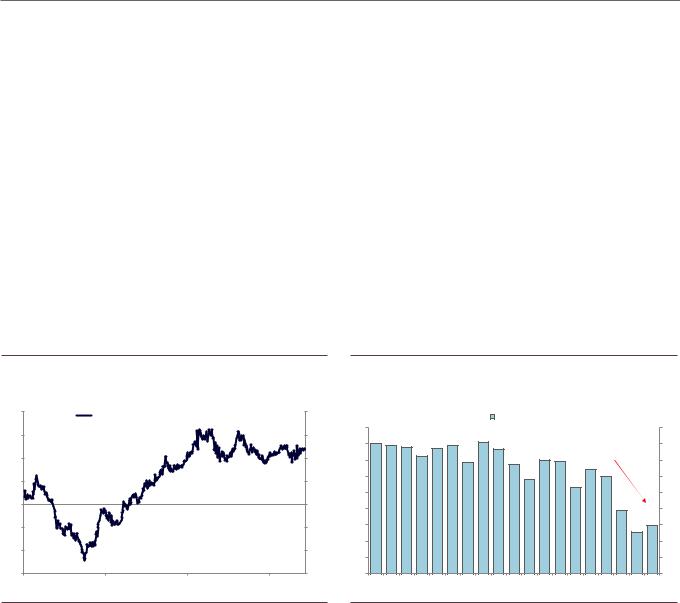
vk.com/id446425943
Goldman Sachs
Global Viewpoint
Short IG idiosyncratic risk funded with AAA CMBX; target: +3%, stop loss: -2%.
We recommend getting short the 3-7% CDX IG series 31 tranche, partly funded with a long position in the AAA CMBX series 11 index, with a 1 to 3.5x notional ratio. The trade is roughly vol-neutral but carry negative (Exhibit 7 for recent performance). In our view, elevated idiosyncratic risk in the low end of the CDX IG quality spectrum will likely cause junior tranches to underperform, while low recession risk should keep spreads on the AAA CMBX index well-behaved. While recent weeks have seen a sharp repricing of idiosyncratic risk in the IG market, the strong exposure of the widest names in the CDX IG index towards sectors facing cyclical and policy challenges such as Autos, as well as structural and late-cycle margin headwinds such as Consumer and Food & Beverage, leaves risk skewed to the downside. As for the long leg of the trade, AAA CMBX, we acknowledge that valuations in the CRE market remain stretched relative to historical norms as well as relative to the residential market. But unlike the low end of the IG quality spectrum, where structural and late-cycle headwinds challenges will constrain the ability to deleverage, there have been tangible signs of adjustment over the past few years, via lower LTVs and tighter lending standards (Exhibit 8).
Exhibit 7: In contrast to 2017, this year has seen little differentiation between the AAA CMBX and the 3-7% CDX IG tranche
Exhibit 8: LTV ratios for commercial mortgages are low relative to pre-crisis levels
8%
6%
4%
2%
0%
-2%
-4%
-6% Nov-16
Long AAA CMBX vs. CDX IG 3-7% (3.5x to 1)
Jun-17 |
Jan-18 |
Aug-18 |
8% |
Ratio |
|
|
|
|
|
|
|
Average LTV |
|
|
|
|
|
|
Ratio |
|||||
|
|
|
|
|
|
|
|
|
|
|
|
|
|
|
|
|
|
||||
6% |
70 |
68 |
|
|
|
|
|
|
68 |
|
|
|
|
|
|
|
|
|
|
|
70 |
68 |
68 |
68 |
|
67 |
68 |
|
67 |
|
|
|
|
|
|
|
|
|
|
68 |
|||
66 |
|
|
|
|
66 |
66 |
|
|
|
|
|
|
|||||||||
4% |
|
|
|
|
|
|
66 |
|
|
65 |
|
|
|
|
|
|
|
|
|||
66 |
|
|
|
|
|
|
|
|
|
|
65 |
|
|
|
|
66 |
|||||
|
|
|
|
|
|
|
|
|
|
64 |
|
|
|
64 |
|
|
|
||||
2% |
64 |
|
|
|
|
|
|
|
|
|
|
|
|
63 |
|
|
|
|
64 |
||
|
|
|
|
|
|
|
|
|
|
|
|
|
|
|
|
|
|
||||
|
|
|
|
|
|
|
|
|
|
|
|
|
|
|
|
|
|
|
|
||
|
62 |
|
|
|
|
|
|
|
|
|
|
|
|
|
|
|
|
|
|
|
62 |
0% |
60 |
|
|
|
|
|
|
|
|
|
|
|
|
|
|
|
|
|
|
|
60 |
|
|
|
|
|
|
|
|
|
|
|
|
|
|
|
|
|
|
|
58 |
||
-2% |
58 |
|
|
|
|
|
|
|
|
|
|
|
|
|
|
|
|
|
57 |
58 |
|
-4% |
56 |
|
|
|
|
|
|
|
|
|
|
|
|
|
|
|
|
|
|
|
56 |
54 |
|
|
|
|
|
|
|
|
|
|
|
|
|
|
|
|
|
|
|
54 |
|
|
|
|
|
|
|
|
|
|
|
|
|
|
|
|
|
|
|
|
|
||
-6% |
52 |
00 |
01 |
02 |
03 |
04 |
05 |
06 |
07 |
08 |
09 |
10 |
11 |
12 |
13 |
14 |
15 |
16 |
17 |
18 |
52 |
|
|
|
|||||||||||||||||||
Source: Goldman Sachs Global Investment Research |
Source: Trepp, Goldman Sachs Global Investment Research |
China: Growth Bottoming Out
Long AUD & NZD vs. EUR; target: 106, stop loss: 97.
We recommend getting long AUD and NZD vs. EUR, indexed to 100 with a total return target of 106 and stop loss at 97 (Exhibit 9). Despite strong domestic fundamentals, AUD has weakened in lockstep with other EM assets this year against a backdrop of China slowdown concerns (Exhibit 10). NZD has faced similar headwinds, as well as additional jitters around political tensions and a more dovish perception of the central bank. Now, with China growth bottoming out and domestic inflationary forces starting to build, we think there is room for a rebound. We recommend funding the trade out of EUR, where a confluence of political risks and growth concerns is likely to cap performance over the next few months and carry is attractive.
15 November 2018 |
4 |
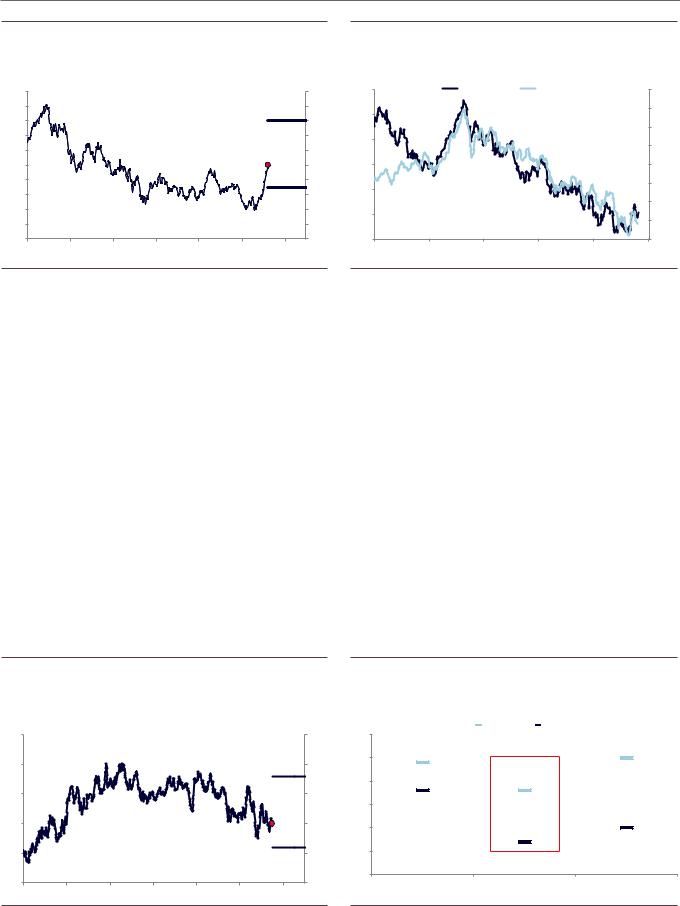
vk.com/id446425943
Goldman Sachs
Global Viewpoint
Exhibit 9: Long AUD & NZD vs. EUR |
Exhibit 10: AUD has weakened against a backdrop of China |
|
slowdown concerns |
Index |
|
Long AUD & NZD vs. EUR |
|
|
Index |
AUD/USD |
|
AUD/USD |
MSCI EM (RHS) |
Index |
|||
110 |
|
|
15Nov2018=100 |
|
|
110 |
0.82 |
|
1,325 |
||||
108 |
|
|
|
|
|
Target=106 |
108 |
0.80 |
|
|
|
|
1,275 |
106 |
|
|
|
|
|
106 |
|
|
|
|
|
||
|
|
|
|
|
|
|
|
|
|
|
1,225 |
||
104 |
|
|
|
|
|
|
104 |
|
|
|
|
|
|
|
|
|
|
|
|
0.78 |
|
|
|
|
1,175 |
||
|
|
|
|
|
|
|
|
|
|
|
|
||
102 |
|
|
|
|
Current=100 |
102 |
|
|
|
|
|
||
|
|
|
|
|
|
|
|
|
|
||||
100 |
|
|
|
|
100 |
0.76 |
|
|
|
|
1,125 |
||
|
|
|
|
|
|
|
|
|
|
||||
98 |
|
|
|
|
|
Stop=97 |
98 |
0.74 |
|
|
|
|
1,075 |
96 |
|
|
|
|
|
|
96 |
|
|
|
|
|
|
|
|
|
|
|
|
|
|
|
|
|
1,025 |
||
94 |
|
|
|
|
|
|
94 |
|
|
|
|
|
|
|
|
|
|
|
|
0.72 |
|
|
|
|
|
||
92 |
|
|
|
|
|
|
92 |
|
|
|
|
975 |
|
|
|
|
|
|
|
|
|
|
|
|
|||
|
|
|
|
|
|
|
|
|
|
|
|
||
90 |
|
|
|
|
|
|
90 |
0.70 |
|
|
|
|
925 |
Jan-17 |
May-17 |
Sep-17 |
Jan-18 |
May-18 |
Sep-18 |
Jan-19 |
|
Sep-17 |
Dec-17 |
Mar-18 |
Jun-18 |
Sep-18 |
Dec-18 |
Source: Bloomberg, Goldman Sachs Global Investment Research |
Source: Bloomberg, Goldman Sachs Global Investment Research |
Long CLP vs CNY; target: 108, stop loss: 96.
We recommend getting long the CLP funded out of the CNY, with a total return target of 108 and a stop of 96. We expect the CLP will likely outperform, for several reasons (Exhibit 11). First, in contrast to most EM economies, domestic growth and inflation pressures in Chile have inflected meaningfully upwards and are supporting a young, carry-rebuilding hiking cycle (Exhibit 12). Second, unlike other Latin American economies, the current administration’s market-friendly stance should keep uncertainty around investment and policy in Chile in check. Third, the trade provides exposure to copper prices, where our commodities team sees upside on both the 3- and 12-month horizons. Fourth, the CLP has priced in a significant deceleration in Chinese growth, and we expect the pace of deceleration to abate going into 2019. Fifth, the CLP is less exposed than other currencies, such as the KRW, to a weakening of the CNY. This should allow the trade to outperform if growth stabilizes in China but the CNY weakens further. Finally, funding the CLP with CNY provides a hedge against an escalation of trade tensions between the US and China. We would emphasize that this trade is about spot moves, not carry. While carry may gradually improve as the hiking cycle in Chile wears on, the trade implies a cost of carry of about 0.5% over a 6-month horizon.
Exhibit 11: Go long Chile’s domestic cycle and copper; hedge the “trade war” risk
Exhibit 12: Chile is in the midst of a young, carry-rebuilding hiking cycle
CLP/CNY total return index. Nov 12, 2018 = 100 |
|
|
|
GS forecasts for Chile |
|
|
|
||||
Index |
|
|
CLP/CNY |
|
|
Index |
% |
2019Q4 |
2018Q3 |
|
|
115 |
|
|
|
|
|
|
115 |
4.5 |
|
|
|
|
|
|
|
|
|
|
|
4.0 |
Inflation target range |
|
|
110 |
|
|
|
|
|
Target = 108 |
110 |
|
|
|
|
|
|
|
|
|
|
|
|
|
|||
|
|
|
|
|
|
|
|
3.5 |
|
|
|
105 |
|
|
|
|
|
|
105 |
3.0 |
|
|
|
|
|
|
|
|
|
|
|
|
|
|
|
100 |
|
|
|
|
|
|
100 |
2.5 |
|
|
|
|
|
|
|
|
|
Current=100 |
|
|
|
|
|
|
|
|
|
|
|
|
|
|
|
|
|
95 |
|
|
|
|
|
Stop = 96 |
95 |
2.0 |
|
|
|
90 |
|
|
|
|
|
|
90 |
1.5 |
|
|
|
Jun-16 |
Dec-16 |
Jun-17 |
Dec-17 |
Jun-18 |
Dec-18 |
YoY growth rate |
YoY inflation rate |
Policy rate |
|||
Dec-15 |
|
|
|
|
|
||||||
Source: Bloomberg, Goldman Sachs Global Investment Research |
Source: Goldman Sachs Global Investment Research |
15 November 2018 |
5 |
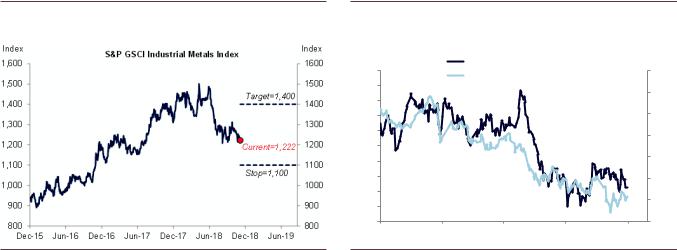
vk.com/id446425943 |
Global Viewpoint |
|
Goldman Sachs |
||
|
|
Long S&P GSCI Industrial Metals Index®; target: 1400, stop loss: 1100. |
Industrial metals declined sharply this year on trade fears, China concerns, and a stronger US Dollar. Contrary to the unfriendly macro environment, the micro fundamentals have been supportive (Exhibit 13). Inventories of copper, aluminum, zinc and nickel have all been falling, indicating that demand has been outpacing supply. While our economists expect continued year-over-year deceleration in China growth and trade disputes may be difficult to resolve in the near term, the market has largely priced in these headwinds, in our view. On the other hand, downward pressure on exports and consumption is likely to lead to more infrastructure investment in China, disproportionally benefiting industrial metals (Exhibit 14).
Exhibit 13: Long S&P GSCI Industrial Metals Index |
Exhibit 14: Copper price has tracked Shanghai Composite Index |
|
this year |
$/t |
|
LME 3m Copper Price |
|
Index |
7,600 |
|
|
3,800 |
|
|
Shanghai Composite Index (RHS) |
|||
7,400 |
|
|
||
|
|
|
3,600 |
|
7,200 |
|
|
|
|
|
|
|
|
|
7,000 |
|
|
|
3,400 |
6,800 |
|
|
|
3,200 |
6,600 |
|
|
|
|
|
|
|
3,000 |
|
6,400 |
|
|
|
|
|
|
|
|
|
6,200 |
|
|
|
2,800 |
6,000 |
|
|
|
2,600 |
5,800 |
|
|
|
|
|
|
|
|
|
5,600 |
|
|
|
2,400 |
Nov-17 |
Feb-18 |
May-18 |
Aug-18 |
Nov-18 |
Source: Bloomberg, Goldman Sachs Global Investment Research |
Source: Bloomberg, Goldman Sachs Global Investment Research |
EM: Pick Up Excess Risk Premium, Have Hedges
Long MSCI EM hedged with MSCI EAFE (1 vs. 1.25); target: 106, stop loss: 97.
We recommend getting long EM equities hedged with non-US DM equities (MSCI EAFE) on a volatility-adjusted basis (1x long EM vs. 1.25x short EAFE) (Exhibit 15). EM equities have been hit harder than global peers this year primarily due to weaker growth outcomes than expected upon entering 2018; and we expect this to reverse next year (Exhibit 16). Specifically, we expect the sequential growth data in China to bottom out in coming months, and that the market will price this in sooner rather than later, particularly as policymakers have begun to show greater willingness to stimulate growth domestically.
Given the late-cycle nature of the US economy and equity valuation ratios that remain high relative to long-term levels, we prefer a relative equity expression over outright longs; and we note that the current growth worries, which have been more US and DM focused (rather than incrementally EM focused), have been better captured in long/short equity trades. Furthermore, on a sector-neutral basis, we find that EM equities trade towards the lower end of their 10-year valuation range relative to MSCI EAFE, which suggests the bar for positive surprise is quite low. For example, MSCI EM bottomed relative to MSCI EAFE on October 11 but the most recent absolute trough was October
15 November 2018 |
6 |
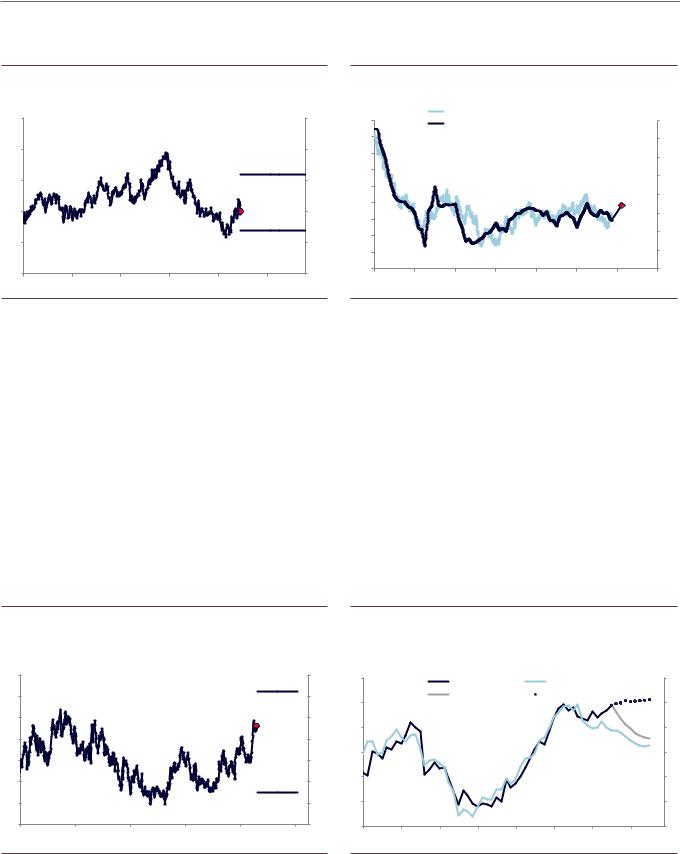
vk.com/id446425943 |
|
|
|
|
|
|
|
|
|
|
Global Viewpoint |
|||
Goldman Sachs |
|
|
|
|
|
|
|
|
|
|
|
|||
|
|
|
29; we suspect the relative outperformance trend to be longer-lasting than the upward |
|||||||||||
|
|
|
trend in equities outright. |
|
|
|
|
|
|
|
|
|||
Exhibit 15: Long global growth with a hedge |
|
|
Exhibit 16: EM equities harder hit relative to their global peers |
|
||||||||||
Index |
|
Long MSCI EM vs Short 1.25x MSCI EAFE |
Index |
Index |
|
MSCI EM vs 1.25x MSCI EAFE |
|
|
% |
|||||
115 |
|
115 |
|
|
|
|||||||||
|
|
|
|
|
105 |
|
EM - Average of Eur and Japan CAI (3mma, RHS) |
8 |
||||||
|
|
|
|
|
|
|
|
|
|
|||||
110 |
|
|
|
|
|
110 |
100 |
|
|
|
|
|
|
7 |
|
|
|
|
Target=106 |
95 |
|
|
|
|
|
|
6 |
||
|
|
|
|
|
|
|
|
|
|
|
|
|||
|
|
|
|
|
(+6%) |
|
90 |
|
|
|
|
|
|
|
105 |
|
|
|
|
|
105 |
|
|
|
|
|
|
5 |
|
|
|
|
|
|
85 |
|
|
|
|
|
Q4 2018 Seq |
|||
|
|
|
|
|
|
|
|
|
|
|
||||
|
|
|
|
|
|
|
|
|
|
|
|
|
||
|
|
|
|
|
|
|
80 |
|
|
|
|
|
GDP Forecast |
4 |
100 |
|
|
|
|
Current=100 |
100 |
|
|
|
|
|
|
3 |
|
|
|
|
|
75 |
|
|
|
|
|
|
||||
|
|
|
|
|
|
|
|
|
|
|
|
|
|
|
|
|
|
|
|
Stop=97 |
|
70 |
|
|
|
|
|
|
2 |
95 |
|
|
|
|
95 |
|
|
|
|
|
|
|
||
|
|
|
|
(-3%) |
65 |
|
|
|
|
|
|
1 |
||
|
|
|
|
|
|
|
|
|
|
|
|
|||
|
|
|
|
|
|
|
|
|
|
|
|
|
||
90 |
|
|
|
|
|
90 |
60 |
|
|
|
|
|
|
0 |
|
|
|
|
|
13 |
14 |
15 |
16 |
17 |
18 |
19 |
|
||
Jan-17 |
Jun-17 |
Nov-17 |
Apr-18 |
Sep-18 |
Feb-19 |
|
|
|||||||
|
|
|
|
|
|
|
|
|
||||||
Source: Goldman Sachs Global Investment Research |
Source: Goldman Sachs Global Investment Research |
Receive a basket of high-yielders 5-year swaps (ZAR, MXN, COP) vs. 10-year swaps in low-yielders (PLN, HUF,THB, KRW); target: 4.3, stop loss: 5.25.
In our view, the risk premium embedded in the high-yielders’ local rates curves is elevated following this year’s repricing (Exhibit 17) . While this partly reflects idiosyncratic local risks and weak EM growth momentum, the bar for upside macro surprises seems low, especially taking into account that negative output gaps in South Africa and Colombia should limit inflation pressures, while policy rates in Mexico are already at high levels. By contrast, in the EM low-yielders (PLN, HUF, THB, and KRW) thinner value buffers, low policy rates and positive output gaps (in CEE) suggest less protection from the global rates repricing that we expect over the coming months (Exhibit 18). Choosing shorter tenors for the long leg (5-year) than for the short leg (10-year) improves the carry profile of the trade and allows for a positive 7bp carry per six months.
Exhibit 17: Harvesting risk premium in the EM high-yielders’ local curves
Exhibit 18: EM HY-LY local rates spread should narrow, according to our EM rates forecasting model
% |
5y EM high yielders minus 10y EM low-yielders swap rates |
% |
% |
|||||
5.4 |
5.4 |
6 |
||||||
|
|
|
|
Stop=5.25 |
||||
|
|
|
|
|
|
|||
|
|
|
|
|
|
|
||
5.2 |
|
|
|
|
|
5.2 |
5 |
|
|
|
|
|
|
|
|
||
5.0 |
|
|
|
|
|
5.0 |
4 |
|
|
|
|
|
|
Current=4.9 |
|
||
4.8 |
|
|
|
|
4.8 |
|
||
|
|
|
|
|
|
|||
4.6 |
|
|
|
|
|
4.6 |
3 |
|
|
|
|
|
|
|
|||
4.4 |
|
|
|
|
|
4.4 |
2 |
|
|
|
|
|
|
|
|||
4.2 |
|
|
|
|
Target=4.3 |
4.2 |
1 |
|
4.0 |
Sep-16 |
May-17 |
Jan-18 |
Sep-18 |
May-19 |
4.0 |
0 |
|
Jan-16 |
|
06 |
||||||
|
5y EM high yielders minus 10y EM low-yielders swap rates |
% |
||||
|
6 |
|||||
|
|
Actual |
|
Fair value |
|
|
|
|
|
|
|
||
|
|
Model forecast |
|
Forwards |
|
5 |
|
|
|
|
|
|
|
|
|
|
|
|
|
4 |
|
|
|
|
|
|
3 |
|
|
|
|
|
|
2 |
|
|
|
|
|
|
1 |
|
|
|
|
|
|
0 |
08 |
10 |
12 |
14 |
16 |
18 |
20 |
Source: Bloomberg, Goldman Sachs Global Investment Research |
Source: Bloomberg, Goldman Sachs Global Investment Research |
15 November 2018 |
7 |
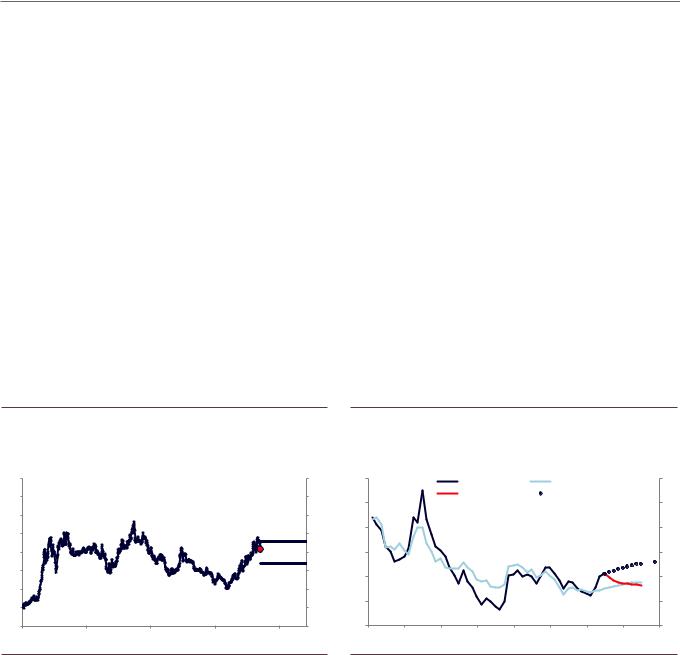
vk.com/id446425943
Goldman Sachs
Global Viewpoint
Long IDR 10-year bonds; yield target: 7.4%, stop loss: 8.6%.
We expect the macro backdrop to be more conducive for IDR bonds in 2019 (Exhibit 19). The sell-off in IDR markets this year has been primarily driven by the combined effect of the sharp back-up in US rates and the 10% rally in DXY. We think this is unlikely to be repeated in 2019. For one, US Treasury yields are near their cycle peak (our 2019 year-end forecast for 10-year yields is 3.5%). Second, we expect the USD to depreciate by almost 6% vs. the DXY in 2019. Our fair value models that screen across EM rates curves indicate that IDR bonds are cheap, and Indo real yields are the highest in the region at 3.3% (1-year IGB at 7.0% vs. 1y inflation expectations of 3.7%) and real rates are now at the top end of their range over the past 10-years (Exhibit 20).
On the fundamental side, Indonesian policymakers have shown a clear commitment towards prioritizing fiscal stability over growth, amid a depreciating IDR. Despite a statutory fiscal deficit ceiling of 3% of GDP; the Indonesian government has kept the fiscal deficit close to 2% of GDP this year. And the 2019 budget outlines a decline to 1.8% of GDP (based on a budget estimate of 2.1% of GDP this year). On the technical side, our positioning survey of benchmarked EM real money funds indicates that investors have gradually reduced their overweight position in Indonesia to almost neutral, which means that positioning is much cleaner than before.
Exhibit 19: We recommend getting long IDR 10-year bonds |
Exhibit 20: Our Asian rates valuation model signals IDR 10-year |
|
rates are cheap relative to forwards |
%, per annum |
|
IDR 10-yr bonds |
|
%, per annum |
%, per annum |
|
|
Indonesia |
|
|
%, per annum |
||
12 |
|
|
|
12 |
16 |
|
|
|
|
|
16 |
||
|
|
|
|
|
|
Actual |
|
Model Fair value |
|||||
|
|
|
|
|
|
|
|
|
|
|
|||
11 |
|
|
|
|
11 |
14 |
|
|
Model Forecast |
Forwards |
14 |
||
|
|
|
|
|
|
|
|
|
|
||||
|
|
|
|
|
|
|
|
|
|
|
|
||
10 |
|
|
|
|
10 |
|
|
|
|
|
|
|
|
9 |
|
|
|
Stop = 8.6% |
9 |
12 |
|
|
|
|
|
|
12 |
|
|
|
|
|
|
|
|
|
|
|
|||
8 |
|
|
|
Current=8.1% |
8 |
10 |
|
|
|
|
|
|
10 |
7 |
|
|
|
Target = 7.4% |
7 |
8 |
|
|
|
|
|
|
8 |
|
|
|
|
|
|
|
|
|
|
|
|
||
6 |
|
|
|
|
6 |
|
|
|
|
|
|
|
|
5 |
|
|
|
|
5 |
6 |
|
|
|
|
|
|
6 |
|
|
|
|
|
|
|
|
|
|
|
|
||
4 |
|
|
|
|
4 |
4 |
|
|
|
|
|
|
4 |
Jan-13 |
Aug-14 |
Mar-16 |
Oct-17 |
May-19 |
|
06 |
08 |
10 |
12 |
14 |
16 |
18 |
20 |
Source: Bloomberg, Goldman Sachs Global Investment Research |
Source: Goldman Sachs Global Investment Research |
Short KRW vs. top-6 currencies in GS trade-weighted basket; target: 106, stop-loss:
97.
A short position in the KRW hedges a wide range of global portfolio risks and is exposed to a weaker domestic outlook (Exhibit 21). Economic growth should be marginally weaker in 2019, with our forecast for GDP at 2.5% vs 2.7% in 2018, primarily due to weaker exports on the tech-cycle slowdown and exposure to China. Notably, chip exports alone accounted for 94% of ytd headline exports growth in 2018 and we forecast that the chip cycle will slow from +50% yoy in 2017, to +30% in 2018 to -3% in 2019 (Exhibit 22). We expect the current account to slow from 4.1% of GDP in 2018 to 3.6% in 2019. Private consumption should moderate following a slowdown in job growth to the weakest level since the GFC, affected by structural factors as well as large policy shocks (a cumulative 30% minimum wage hike over 2018-2019). A short position
15 November 2018 |
8 |
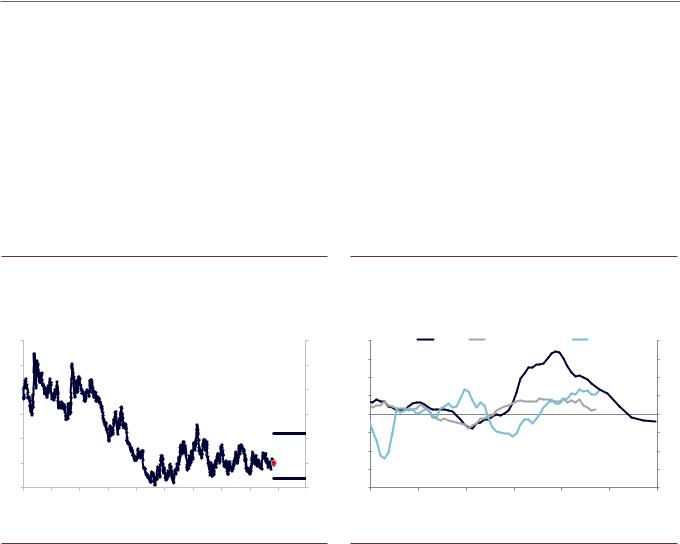
vk.com/id446425943
Goldman Sachs
Global Viewpoint
in the KRW also hedges the risk of a further tech-led equity sell-off since the Won is one of the most equity-centric currencies. Lastly, widening rate differentials with the US could also prompt further portfolio outflows.
We prefer to express this short KRW trade versus the trade-weighted currency basket as opposed to the USD, given the near-term uncertainty in Dollar directions, although both implementations benefit from positive carry. We recommend going short the KRW versus the top-6 currencies in the GS trade-weighted basket (TWI), comprising CNY (40.9%), USD (19.3%), EUR (14.7%), JPY (14.3%), AUD (5.7%) and TWD (5.1%). This position (short KRW vs TWI) also offers carry of 0.9% per annum. We selected this basket as it represents six liquid currencies which account for around 75% of the GS trade-weighted currency index.
Exhibit 21: Go short KRW vs. top-6 currencies in a GS |
Exhibit 22: Economic growth expected to slow |
trade-weighted basket |
Semiconductor exports growth |
2 Nov 2018 = 100 |
|
|
|
|
|
|
|
|
|
|
|
|
|
|
|
|
|
Index |
|
|
Short KRW trade weighted currency basket |
Index |
% change, yoy |
|
|
|
|
|
% change, yoy |
||||||
125 |
|
|
|
125 |
80 |
|
Korea |
Other Asia exporters |
|
China |
80 |
||||||
|
|
|
|
|
|
|
|
|
|
|
|||||||
120 |
|
|
|
|
|
|
|
|
|
120 |
60 |
|
|
|
|
|
60 |
|
|
|
|
|
|
|
|
|
|
|
|
|
|
|
|
||
|
|
|
|
|
|
|
|
|
|
|
40 |
|
|
|
|
|
40 |
115 |
|
|
|
|
|
|
|
|
|
115 |
20 |
|
|
|
|
|
20 |
|
|
|
|
|
|
|
|
|
|
|
|
|
|
|
|
||
110 |
|
|
|
|
|
|
|
|
|
110 |
0 |
|
|
|
|
|
0 |
|
|
|
|
|
|
|
|
|
Target=106 |
|
-20 |
|
|
|
|
|
-20 |
105 |
|
|
|
|
|
|
|
|
|
105 |
|
|
|
|
|
||
|
|
|
|
|
|
|
|
Current=100 |
-40 |
|
|
|
|
|
-40 |
||
|
|
|
|
|
|
|
|
|
|
|
|
|
|
|
|
||
100 |
|
|
|
|
|
|
|
|
Stop=97 |
100 |
-60 |
|
|
|
|
|
-60 |
|
|
|
|
|
|
|
|
|
|
|
|
|
|
|
|||
|
|
|
|
|
|
|
|
|
|
|
|
|
|
|
|
|
|
95 |
|
|
|
|
|
|
|
|
|
95 |
-80 |
|
|
|
|
|
-80 |
10 |
11 |
12 |
13 |
14 |
15 |
16 |
17 |
18 |
19 |
|
14 |
15 |
16 |
17 |
18 |
19 |
|
Note: KRW currency index vs. GS trade-weighted basket (TWI), comprising CNY (40.9%), USD (19.3%), EUR (14.7%), JPY (14.3%), AUD (5.7%) and TWD (5.1%).
Note: Other Asia exporters include Malaysia, Singapore, Taiwan and Thailand; dotted line denotes GS forecast
Source: Bloomberg, Goldman Sachs Global Investment Research |
Source: Haver Analytics, Goldman Sachs Global Investment Research |
Brexit: Deal Dividend
Pay 2y1y SONIA vs. receive 2y1y EONIA; target: 145bp, stop loss: 75bp.
Brexit risks are weighing on UK yields. We expect that an eventual deal will allow UK rates to move higher on both a reduction of uncertainty and upcoming fiscal expansion (Exhibit 23). At the same time, risks to Euro area activity remain skewed to the downside. While our modal case is for one ECB hike in 2019, we think the probability of a dovish revision to the EUR rate path is relatively high (40%). With Italy risks unresolved, we think UK rates can decouple from EUR rates in the wake of a positive Brexit outcome (Exhibit 24). The main risk is the Brexit deal itself, which is a digital event and so presents jump risk in both directions.
15 November 2018 |
9 |
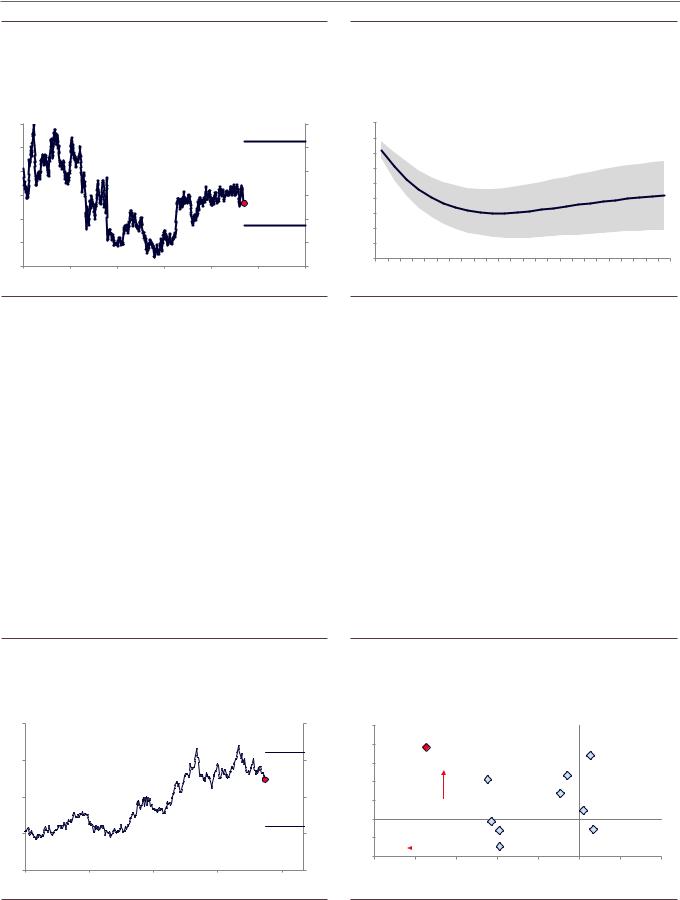
vk.com/id446425943
Goldman Sachs
Global Viewpoint
Exhibit 23: Contingent on a final Brexit deal, we expect markets will price more BoE hikes
Exhibit 24: Wider Italian spreads are likely to keep ECB hike expectations in check
Response of EUR2y1y swap rates to 1 standard deviation shock in EA GDP-weighted 10y spread
bp |
|
2y1y SONIA - 2y1y EONIA |
|
bp |
bp |
||
160 |
|
|
|
|
|
160 |
0 |
140 |
|
|
|
|
Target=145bp |
140 |
-2 |
|
|
|
|
|
-4 |
||
|
|
|
|
|
|
|
|
120 |
|
|
|
|
|
120 |
-6 |
|
|
|
|
|
|
||
|
|
|
|
|
|
|
-8 |
100 |
|
|
|
|
Current=93bp |
100 |
-10 |
|
|
|
|
|
|
||
|
|
|
|
|
|
-12 |
|
80 |
|
|
|
|
Stop=75bp |
80 |
|
|
|
|
|
-14 |
|||
|
|
|
|
|
|
|
|
60 |
|
|
|
|
|
60 |
-16 |
40 |
|
|
|
|
|
40 |
-18 |
|
|
|
|
|
|
||
Jan-15 |
Nov-15 |
Sep-16 |
Jul-17 |
May-18 |
Mar-19 |
|
|
|
|
|
|
|
|
|
|
|
+2 Std dev. |
|
|
|
|
|
|
|
|
|
-2 Std dev. |
1 |
2 |
3 |
4 |
5 |
6 |
7 |
8 |
9 |
10 11 12 13 14 15 16 17 18 19 20 21 22 23 24 |
|
|
|
|
|
|
|
|
|
Months after shock |
Source: Bloomberg, Goldman Sachs Global Investment Research |
Source: Goldman Sachs Global Investment Research |
Central Banks: Data Driving Divergence
Short EUR/SEK; target: 9.60, stop loss: 10.60.
We recommend getting short EUR/SEK with a target of 9.60, or spot return of roughly 6.5% (Exhibit 25). The economy in Sweden is operating well beyond potential, inflation is on target, and yet policy remains accommodative (Exhibit 26). To be fair, this has been the case for some time now, but we think “this time is different” as the Riksbank’s communication about normalization has become decidedly more concrete in recent months. Our analysis suggests policymakers in Sweden will ultimately need to tighten policy sooner and more aggressively than their counterparts at the ECB, and we expect this will include some SEK appreciation. While domestic policy should provide some protection, the main risk to this trade is a more marked deterioration in Euro area sentiment, which tends to weigh on SEK. This supplants our previous trade recommendation to go long an equally-weighted basket of SEK and NOK, which we close for a potential profit of 1.05%.
Exhibit 25: We recommend getting short EUR/SEK as the Riksbank turns
Exhibit 26: The economy in Sweden is operating well beyond potential, inflation is on target, and yet policy remains very accommodative
EUR/SEK |
|
EUR/SEK |
|
EUR/SEK |
Output gap |
|
|
|
|
|
|
|
11.0 |
|
|
11.0 |
2.5 |
|
|
|
|
|
|
|
|
|
|
|
SEK |
|
|
|
|
|
|
|||
|
|
|
|
|
|
|
|
|
|
|
|
|
|
|
|
|
Stop=10.6 |
2.0 |
|
|
|
|
|
USD |
|
|
|
|
|
|
|
|
|
|
CAD |
|
|
|
10.5 |
|
|
|
10.5 |
1.5 |
|
|
CHF |
|
|
|
|
|
|
|
|
|
|
|
|
|
|
|
||
|
|
|
|
Current=10.2 |
1.0 |
Economy |
|
|
JPY |
|
|
|
|
|
|
|
|
|
|
|
|
|
|||
10.0 |
|
|
|
10.0 |
0.5 |
running hot |
|
|
|
|
NZD |
|
|
|
|
|
|
|
|
GBP |
|
|
|
||
|
|
|
|
|
|
|
|
|
|
|
||
|
|
|
|
Target=9.6 |
0.0 |
|
|
|
|
|
|
|
|
|
|
|
|
|
NOK |
|
|
|
|
||
9.5 |
|
|
|
9.5 |
|
Policy more |
|
|
AUD |
|
||
|
|
|
-0.5 |
EUR |
|
|
|
|||||
|
|
|
|
|
accommodative |
|
|
|
|
|||
|
|
|
|
|
-1.0 |
|
|
|
|
|
|
|
9.0 |
|
|
|
9.0 |
-2.5 |
-2.0 |
-1.5 |
-1.0 |
-0.5 |
0.0 |
0.5 |
1.0 |
|
|
|
|
|
|
Real policy rate |
|
|
|
|||
Jan-17 |
Jul-17 |
Jan-18 |
Jul-18 |
Jan-19 |
|
|
|
|
|
|
||
Source: Bloomberg, Goldman Sachs Global Investment Research |
Source: Bloomberg, Goldman Sachs Global Investment Research |
15 November 2018 |
10 |
